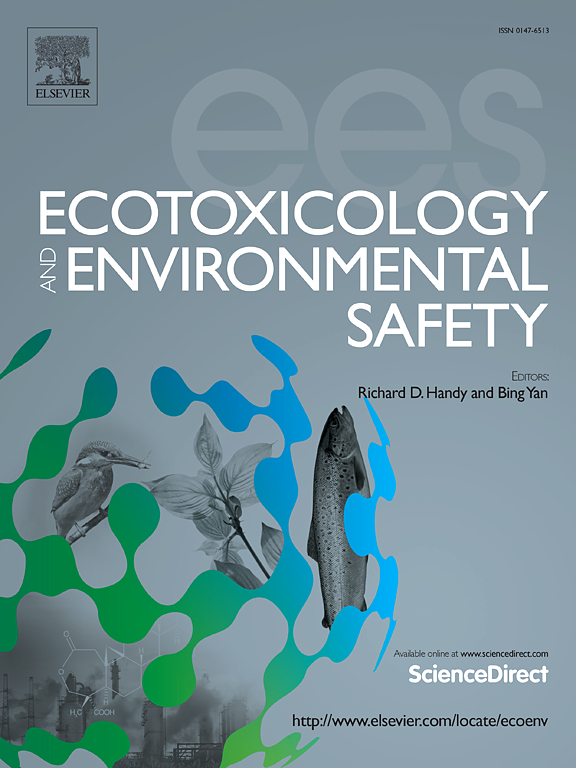母体铅暴露通过AMPK/ULK1通路激活损害子代生长和肠道微生物群
IF 6.2
2区 环境科学与生态学
Q1 ENVIRONMENTAL SCIENCES
引用次数: 0
摘要
铅(Pb2 +)在生物体中的普遍存在和生物积累对人类健康构成重大风险。关于铅的神经毒性和生殖毒性已经进行了广泛的研究,但母亲接触铅对后代的影响仍然需要解决。因此,我们旨在探讨妊娠小鼠铅暴露对下一代的不良影响及其机制。本研究表明,铅暴露会降低下一代小鼠的生长性能,损害结肠、脾脏、睾丸和肾脏的功能。此外,我们发现铅暴露通过调节AMPK/ULK1途径激活自噬,并以剂量依赖的方式降低紧密连接蛋白的相对表达水平。此外,与对照组相比,肠道微生物群的组成发生了显著变化。这些变化的特点是有益菌(包括Variovorax、Harryflintia和Romboutsi)的相对丰度显著减少,而致病菌(如Mucispirillum和Klebsiella)的丰度显著增加。微生物组成的这种变化表明微生物体内平衡受到破坏,导致健康受损。综上所述,我们的研究表明,妊娠小鼠暴露于铅不仅会降低下一代小鼠的生长性能和多个器官受损,还会通过激活AMPK/ULK1通路破坏肠道微生物稳态并诱导自噬,从而导致后代的不良健康结果。此外,本研究为世界各地的环境机构实施有效的策略来减轻铅污染提供了坚实的实验基础。本文章由计算机程序翻译,如有差异,请以英文原文为准。
Maternal lead exposure impairs offspring growth and intestinal microbiota via AMPK/ULK1 pathway activation
The pervasive presence and bioaccumulation of lead (Pb2 +) in living organisms pose a significant risk to human health. Extensive research has been conducted on the neurotoxicity and reproductive toxicity of lead, but the impact of maternal lead exposure on subsequent generations still needs to be addressed. Therefore, we aimed to explore the adverse effects and mechanisms of lead exposure in pregnant mice on the next generation. The present study indicated that lead exposure decreased growth performance and impaired the function of the colon, spleen, testes, and kidneys in the next generation of mice. Furthermore, we found that lead exposure activated autophagy by regulating the AMPK/ULK1 pathway and reduced the relative expression levels of tight junction proteins in a dose-dependent manner. Moreover, the composition of the gut microbiota showed significant alterations compared to the control group. These changes were characterized by a marked reduction in the relative abundance of beneficial bacteria, including Variovorax, Harryflintia, and Romboutsi, while the abundance of pathogenic bacteria such as Mucispirillum and Klebsiella was significantly increased. Such shifts in microbial composition indicated a disruption in microbial homeostasis, contributing to health impairments. In summary, our study indicated that lead exposure in pregnant mice not only decreased the growth performance and impaired multiple organs in the next generation of mice but also disrupted gut microbial homeostasis and induced autophagy via activating the AMPK/ULK1 pathway, resulting in adverse health outcomes in offspring. Additionally, the current study provides a solid experimental foundation for environmental agencies worldwide to implement effective strategies to mitigate lead contamination.
求助全文
通过发布文献求助,成功后即可免费获取论文全文。
去求助
来源期刊
CiteScore
12.10
自引率
5.90%
发文量
1234
审稿时长
88 days
期刊介绍:
Ecotoxicology and Environmental Safety is a multi-disciplinary journal that focuses on understanding the exposure and effects of environmental contamination on organisms including human health. The scope of the journal covers three main themes. The topics within these themes, indicated below, include (but are not limited to) the following: Ecotoxicology、Environmental Chemistry、Environmental Safety etc.

 求助内容:
求助内容: 应助结果提醒方式:
应助结果提醒方式:


